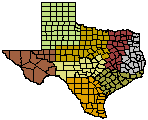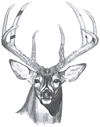- Trans Pecos
- High Plains/Panhandle
- Cross Timbers
- Hill Country
- Post Oak Savannah
- Pineywoods
- Oak Prairie
- South Texas Plains

Wildlife Division District Map
South Texas Wildlife Management
Historical Perspective

White-tailed deer buck.
The native rangelands of south Texas have long been noted for its cattle industry and abundant wildlife, especially the trophy white-tailed deer. South Texas contains some of the states premium deer habitat providing excellent amounts of food and cover. However, the vegetative diversity and wildlife abundance has not always been what you see today. History of the settlement and changes in the natural landscape that took place in the Rio Grande plains can be broken down into three time periods: Spanish exploration from 1600 to the 1700s, Colonization of Texas from 1821 to 1863 and Cattle Empire from 1860 to the early 1900s.
Spanish Colonization 1600 to the 1700s
Early Spanish explorers had very diverse descriptions of the region with some claiming poor grazing areas while others reported rich fertile pastureland. These discrepancies were due in part to season of travel, amount of rainfall, and route of travel. Tall grass prairies covered with little bluestem, switchgrass, and other native grasses sprawled across the eastern half of the region by some accounts, while the western portion of south Texas in a much drier climate was described as a short grass prairie. The general consensus among early Spanish explorers was that the south Texas plains were predominately a prairie interspersed with mesquite, prickly pear and other woody vegetation. Much of the dense brush was limited to rivers, creeks, drainages, and in small mottes on the prairie. Natural fires were a frequent occurrence and kept much of the brush from infesting the prairie. South Texas was much less brushy 400 years ago than today.
Except for a few buffalo, antelope and deer, there was very little natural grazing pressure during this period. Various observers reported deer in all types of habitat from open prairies, the coastal sand plains with limited brush, into the dense chaparral and trees. In the Teran expedition of 1691, Manzanet observed great numbers of buffalo and deer in a "level region without trees" in northern Medina County. Juan Antonio de la Pena's diary of the Aguayo expedition of 1722 reported from an area near the Medina/Atascosa County line, "During the remainder of the day we passed through a flat country and found a great many deer. We saw around us, almost at the same time, as many as three or four hundred of these animals."
Colonization of Texas 1821 to 1863
The American travelers and explorers during the nineteenth century appeared to show a greater interest in the wildlife of south Texas than the earlier Spanish explorers. Apparently, these travelers were more dependent on the natural resources for survival than the well-financed Spaniards who tended to take livestock with them. During this time there was very little grazing pressure. Wild horses that were left or escaped from Spanish were common which added to the native wildlife. As settlement of south Texas increased, livestock steadily began coming into the region and allowed to range freely. There were no fences at this time and animals were moved when necessary to better forage. Deer were plentiful during this period and used for food and hide. Sanchez reported in 1828 as he approached the Nueces River in southern LaSalle County near the San Antonio-Laredo road, "herds of deer on fertile plains". In western LaSalle County between the Frio and Nueces rivers, Bollaert saw "deer in cords" in 1843. He also saw deer and antelope together as he traveled over "mesquite prairies with brushy spots" through northwestern Frio and southwestern Zavala counties. He reported seeing deer or deer sign in McMullen, LaSalle, Frio and Live Oak counties in thick dense chaparral. In 1844, Kirby-Smith reported in Nueces County "more deer than I supposed existed in America".
In 1849, Whitigs' hunters brought many deer to his camp located in western Kinney County. He also reported an abundance of fat and tender venison in some of the finest mesquite land he had ever seen between Brackettville and the Nueces River in Uvalde County. In 1853, Bartlett reported deer and antelope in great numbers in Brooks County that was on a rolling prairie without trees. Continuing on toward Kingsville, he reported that his party could see miles and saw large numbers" of deer and antelope. As he traveled on towards Corpus Christi where "not a bush or tree was to be seen", his party saw thousands of deer and antelope and stated that never before had they seen them in such great numbers. Jack Inglis suggested in "A History of Vegetation in the Rio Grande Plains" that these great numbers might have resulted from the drift of animals before a prairie fire they encountered later on. Historical observations of deer in the thick bottomlands were limited, probably due more to the thick vegetation and lack of visibility instead of the lack of animals.
The Ranching Empire 1860 to the early 1900s
Early ranchers thought the grass would last forever in Texas. As a result, livestock pressure increased with cattle, sheep and goats, and fencing confined them. Settlement also decreased natural fires. From the late 1860s through the 1890s many south Texas counties had more sheep than cattle. Beginning in 1867, a half million sheep were grazed for 3 decades. In 1880, sheep in south Texas represented 45% of Texas' sheep population. In 1889 in the Rio Grande Plains had the four leading sheep producing counties in the state and 10 of the top 15 counties were in south Texas. The peak decade was from 1880 to 1890 at times exceeding two million head. Sheep were an important ecological factor in changing the landscape and literally grazed themselves out of south Texas.
The main factors for change in vegetation in south Texas included overgrazing by livestock, diminished occurrence of natural fire, relatively poor soil (water penetration, nutritive value, aeration, crusting, etc.), climate and precipitation fluctuations, and plenty of brush for seed stock. In the past these factors caused the few natural grazers to rotate to different grazing areas. This region has an overall poor ability for the land to recover due to climate and soil types. As vegetation changed and brush increased, deer numbers subsequently increased.
As settlement of south Texas increased, deer harvest increased and quality habitat decreased. Deer that had survived historically in the open rangelands could no longer survive there. They were forced into the thicker areas. Besides food deer were hunted for their hides. Until 1900 market hunting was common throughout southwest and eastern Texas and even as late as 1925. Sale of deer hides was an important item of trade before 1900 and many were professionally killed for hides only. Market hunting occurred in south Texas, but the extent is unknown. The majority of the hunting from the 1890s through the early 1900s hunting was from ranchers with a few outside hunters.
From 1900 through the 1930s, deer hunting was for meat with little regard for age or sex. During this time there were lots of good bucks, very few hunters, large tracts of land, very little access (no roads), few vehicles, and hunting was hard. Most hunters could trespass for free just by asking. The increase in brush density was considered the worst thing to happen to the range and in the late 1930s intensive brush control began that would impact wildlife in Texas for generations.
Attitudes changed in the 1940s to 1950s when hunters began looking for trophy bucks. Access to hunting areas became easier with more roads and vehicles. The oil industry precipitated this change to a large extent. Brush control types and techniques continued and advanced. Landowners found economic incentives through leasing to begin protecting the deer herd and they began protecting females. The hunting lease system was in total operation by the 1950 and 1960s and accessibility increased, as did more vehicles.
In the late 1950s, Texas Game and Fish Commission initiated the South Central Game Management Survey and began wildlife inventories and research in south Texas. By the 1950s extensive brush control and eradication was in full operation. By the late 1960s wildlife managers became concerned about the effect of brush control on habitat and wildlife. While deer in south Texas have been plentiful throughout recent history, the numbers of trophy bucks were reportedly decreasing. By the 1970s deer were an economically important commodity and management began in earnest!
The history of south Texas from early Spanish exploration, through settlement and colonization, into the present shows us that managing the habitat and its resources is the most important and critical aspect of maintaining quality wildlife populations.